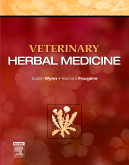|
|
|
| |
 |
|
|

|
 推薦指數:
推薦指數:





|
|
- 內容介紹
|
Veterinary Herbal Medicine
By Susan G. Wynn, DVM and Barbara Fougere, BVSc, BVMS(Hons)
736 pages 201 ills
Trim size 8 1/2 X 10 7/8 in
Copyright 2007
Description
This full-color reference offers practical, evidence-based guidance on using more than 120 medicinal plants, including how to formulate herbal remedies to treat common disease conditions. A body-systems based review explores herbal medicine in context, offering information on toxicology, drug interactions, quality control, and other key topics.
Key Features
More than 120 herbal monographs provide quick access to information on the historical use of the herb in humans and animals, supporting studies, and dosing information.
Includes special dosing, pharmacokinetics, and regulatory considerations when using herbs for horses and farm animals.
Expanded pharmacology and toxicology chapters provide thorough information on the chemical basis of herbal medicine.
Explores the evolutionary relationship between plants and mammals, which is the basis for understanding the unique physiologic effects of herbs.
Includes a body systems review of herbal remedies for common disease conditions in both large and small animals.
Discusses special considerations for the scientific research of herbs, including complex and individualized interventions that may require special design and nontraditional outcome goals.
Table of Contents
1. Why Use Herbs?
I. Historical Relationship between Plants and Animals
2. Zoopharmacognosy
3. Ethnoveterinary Medicine: Potential Solutions for Large-Scale Problems
4. The Roots of Veterinary Botanical Medicine
5. Overview of Traditional Chinese Medicine: The Cooking Pot Analogy
6. Ayurvedic Veterinary Medicine: Principles and Practices
II. Herbal Medicine Controversies
7. Evaluating, Designing and Accessing Herbal Medicine Research
8. Regulation and Quality Control
9. A Skeptical View of Herbal
Medicine III. The Plants
10. Medical Botany
11. Plant Chemistry in Veterinary Medicine: Medicinal Constituents and their Mechanisms of Action
12. Herbal Medicine: Potential for Intoxication and Interactions with Conventional Drugs
13. Herbal Energetics: The Key to Efficacy in Herbal Medicine
14. Herb Manufacture, Pharmacy and Dosing
15. Herbal Materia Medica
16. Designing the Medicinal Herb Garden
17. Commercial Organic Herb Production for Veterinary Medicine
18. Conserving Medicinal Plant Biodiversity
19. Safe Substitutes for Endangered Herbs: Plant Conservation and Loss of our Medicines
IV. Veterinary Clinical Uses of Medicinal Plants
20. Approaches in Veterinary Herbal Medicine Prescribing
21. Herbs for Hematologic and Immunologic Disorders
22. Herbal Medicine in Equine Practice
23. Phytotherapy for Dairy Cows
24. Organic Management of Food Producing Livestock
25. Clinical Practice
V. Resources
A. Client Handouts
a. How to Administer Herbs
b. How to Report Adverse Events
B. Training in Herbal Medicine
C. Suppliers
D. Websites and Other Texts
|
|
|

